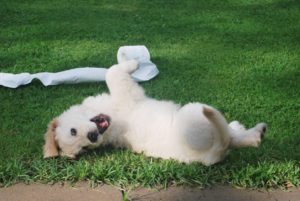
It’s a parent’s rite of passage – potty training. And whether you’re potty training a two-legged or a four-legged kid, the struggle is real. There will be accidents. There may be crying. There is no “one size fits all” approach to potty training, but the experts all agree on this: with some perseverance and some patience, there will be success.
Crate Training
Mary Burch, Ph.D., and director of the American Kennel Club’s Canine Good Citizen and S.T.A.R. Puppy programs, says crate training is a tried-and-true method for potty training your puppy.
Why a crate?
Dogs are den animals by nature. A crate serves as a type of den for Fido – a place where he can feel safe and secure. Fido is far less likely to potty in his den; after all, it’s his living space. That’s why training your dog to use a crate can be an effective method for potty training.
Mara Bovsun of the American Kennel Club says, “It’s important that the crate is the right size—just large enough for the dog to lie down, stand up, and turn around. If it is too large, the dog will feel that it’s OK to use one corner for elimination and then happily settle down away from the mess.”
Bell Training
Training Fido to ring a bell when he needs to go outside to potty can be a great way to teach him. The sound also alerts you to his needs instead of constantly keeping him within sight to try and interpret his body language like pacing and sniffing the ground.
Rover.com recommends a three-step process for potty training your dog with a bell:
1) Train Fido to touch the bell with his nose
2) Make sure Fido only rings the bell at the door you use to take him outside to potty
3) Teach Fido to ring the bell ONLY when he needs to go out to potty instead of whenever he wants to be outside (dogs can be sneaky like that!)
You can use any type of bell for potty training. While there are bells specifically made for this purpose, bell training can be just as effective with a bird bell or even jingle bells. Remember that consistency is key to success.
Setting a Schedule
Experts agree that for potty training to be successful, Fido needs a schedule. You probably already have a schedule in place for Fido—you get up and go to bed at a certain time each day and your dog likely follows suit. Fido’s feeding schedule should also be consistent, with meals at specific times each day. Dogs like routine, so setting a potty schedule will aid his training.
What does a potty schedule look like?
Each dog (and each household) is different, so schedules should be made to work with you and your dog to keep things running as smoothly as possible. PetMD.com recommends that you schedule potty breaks throughout the day.
1) When you and Fido wake up in the morning
2) After meals
3) After playtime
4) Before bed
Keep in mind that puppies have smaller bladders and can’t hold it as long as an older dog may be able to. A general guideline is an hour of hold time for each month of age. For example, a three-month-old puppy can usually hold it for about three hours. This means you’ll need to make more frequent trips outside with your puppy until he’s been properly trained.
Shane Wisdom, Certified Professional Dog Trainer and owner of DogWisdom, says that one of the most important aspects to training your dog is knowing the “rules of being a dog.” In other words, people need to learn how to speak their dog’s language in order to better understand and train them.
As a behavioral expert, Wisdom knows that one of the most common reasons dogs end up in shelters is because of potty training issues. A lack of consistent training and patience can have devastating consequences for your dog. That’s why he created the Gotta Potty™ training system. The system helps train dog owners to better understand their dog’s body language to aid in the success of potty training.
Positive Reinforcement
Kristina Lotz, Knowledge-Assessed Certified Professional Dog Trainer, believes positive reinforcement is a crucial element to successful potty training. Doling out punishments or negative reinforcement when your dog has an accident isn’t likely to solve anything—it could actually prolong the problem.
Lotz says that dogs don’t understand our reasoning. If you get upset because Fido had an accident in the house and respond by yelling and rubbing his nose in it, he may know you sound mad about something but won’t associate you’re rubbing his nose in the spot of the accident with why you’re upset. Instead, Fido may just think that means you don’t want to see the accident, so he’ll find a more discrete place next time, like behind the couch.
While it’s easy to get upset when your dog has an accident in the house, try to stay calm and think about what may have caused the accident. Be honest with yourself. Did you wait too long to take him out? Did you give him too much leeway in the house or decide to forgo the crate while you ran a quick errand? Did you vary too much from the potty schedule? These things may have inadvertently set Fido up to fail.
So what can you do about it?
When you do a good job at work or you make a great meal for your family, a little praise goes a long way. It’s the same for Fido. Every time you take him outside to potty and he goes, reward him. Praise him, tell him he’s a good boy, give him a treat. In other words, throw him a party!
Your dog wants to please you and do what you want. If you help him understand what you want, he’ll be the good boy you want him to be and you’ll both be happy!
